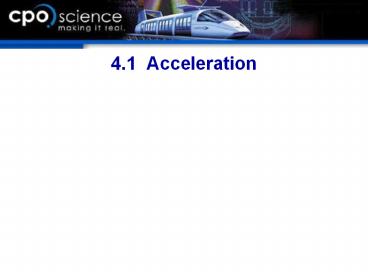4.1 Acceleration - PowerPoint PPT Presentation
1 / 20
Title:
4.1 Acceleration
Description:
4.1 Acceleration Chapter Objectives Calculate acceleration from the change in speed and the change in time. Give an example of motion with constant acceleration. – PowerPoint PPT presentation
Number of Views:201
Avg rating:3.0/5.0
Title: 4.1 Acceleration
1
4.1 Acceleration
2
Chapter Objectives
- Calculate acceleration from the change in speed
and the change in time. - Give an example of motion with constant
acceleration. - Determine acceleration from the slope of the
speed versus time graph. - Calculate time, distance, acceleration, or speed
when given three of the four values. - Solve two-step accelerated motion problems.
- Calculate height, speed, or time of flight in
free fall problems. - Explain how air resistance makes objects of
different masses fall with different
accelerations.
3
Chapter Vocabulary
- acceleration
- acceleration due to gravity (g)
- air resistance
- constant acceleration
- delta (?)
- free fall
- initial speed
- m/s2
- term
- terminal velocity
- time of flight
- uniform acceleration
4
Inv 4.1 Acceleration
- Investigation Key Question
- How does acceleration relate to velocity?
5
4.1 Acceleration
- Acceleration is the rate of change in the speed
of an object. - Rate of change means the ratio of the amount of
change divided by how much time the change takes.
6
4.1 Acceleration in metric units
- If a cars speed increases from 8.9 m/s to 27
m/s, the acceleration in metric units is 18.1
m/s divided by 4 seconds, or 4.5 meters per
second per second. - Meters per second per second is usually written
as meters per second squared (m/s2).
7
4.1 The difference between velocity and
acceleration
- Velocity is fundamentally different from
acceleration. - Velocity can be positive or negative and is the
rate at which an objects position changes. - Acceleration is the rate at which velocity
changes.
8
4.1 The difference between velocity and
acceleration
- The acceleration of an object can be in the same
direction as its velocity or in the opposite
direction. - Velocity increases when acceleration is in the
same direction.
9
4.1 The difference between velocity and
acceleration
- When acceleration and velocity have the opposite
sign the velocity decreases, such as when a ball
is rolling uphill.
10
4.1 The difference between velocity and
acceleration
- If both velocity and acceleration are negative
the speed increases but the motion is still in
the negative direction. - Suppose a ball is rolling down a ramp sloped
downhill to the left. - Motion to the left is defined to be negative so
the velocity and acceleration are both negative. - The velocity of the ball gets LARGER in the
negative direction, which means the ball moves
faster to the left.
11
4.1 Calculating acceleration
- Acceleration is the change in velocity divided by
the change in time. The Greek letter delta (?)
means the change in.
Change in speed (m/sec)
a Dv Dt
Acceleration (m/sec2)
Change in time (sec)
12
4.1 Calculating acceleration
- The formula for acceleration can also be written
in a form that is convenient for experiments.
13
Calculating acceleration in m/s2
A student conducts an acceleration experiment by
coasting a bicycle down a steep hill. A partner
records the speed of the bicycle every second for
five seconds. Calculate the acceleration of the
bicycle.
- You are asked for acceleration.
- You are given times and speeds from an
experiment. - Use the relationship a (v2 v1) (t2
t1) - Choose any two pairs of time and speed data since
the change in speed is constant. - a (6 m/s 4 m/s) (3 s 4 s) (2 m/s)
(-1 s) - a -2 m/s
14
4.1 Constant speed and constant acceleration
- Constant acceleration is different from constant
speed. - If an object is traveling at constant speed in
one direction, its acceleration is zero. - Motion with zero acceleration appears as a
straight horizontal line on a speed versus time
graph.
15
4.1 Uniform acceleration
- Constant acceleration is sometimes called uniform
acceleration. - A ball rolling down a straight ramp has constant
acceleration because its speed is increasing at
the same rate. - Falling objects also undergo uniform acceleration.
16
4.1 Constant negative acceleration
- Consider a ball rolling up a ramp.
- As the ball slows down, eventually its speed
becomes zero and at that moment the ball is at
rest. - However, the ball is still accelerating because
its velocity continues to change.
17
4.1 The speed vs. time graph for accelerated
motion
- In this experiment, velocity and acceleration are
in the same direction. - No negative quantities appear, and the analysis
simply uses speed instead of velocity.
18
(No Transcript)
19
4.1 Slope and Acceleration
- Use slope to recognize acceleration on speed vs.
time graphs. - Level sections (A) on the graph show an
acceleration of zero. - The highest acceleration (B) is the steepest
slope on the graph. - Sections that slope down (C) show negative
acceleration (slowing down).
20
Calculating acceleration
The graph shows the speed of a bicyclist going
over a hill. Calculate the maximum acceleration
of the cyclist and calculate when in the trip it
occurred.
- You are asked for maximum acceleration.
- You are given a graph of speeds vs. time.
- Use the relationship a slope of graph
- The steepest slope is between 60 and 70 seconds,
when the speed goes from 2 to 9 m/s. - a (9 m/s 2 m/s) (10 s)
- a 0.7 m/s2































